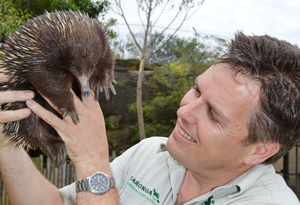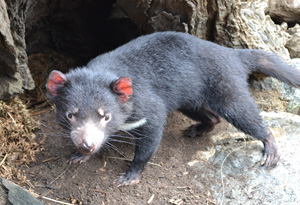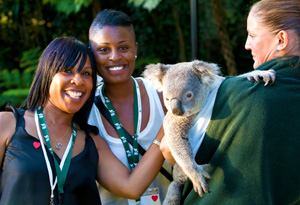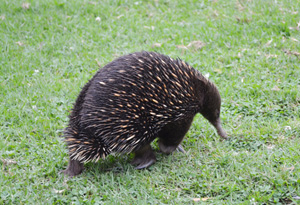Inside Sydney's Taronga Zoo
Q&A with Education Manager Paul Maguire

Oprah Show Ultimate Viewers spent a memorable evening at this popular Sydney attraction. Learn more about its unique history and conservation efforts from Paul, the education manager. Plus, meet his favorite (sneaky!) zoo animal.
Kari Forsee, Oprah.com: How did you become interested in animals?Paul Maguire: I grew up in the Bush, in the Blue Mountains. I've always had animals around—my dad was a bit of a bird watcher—and I did a teaching sport degree as well as camping with kids. When this job came up to work at the zoo, combining both animals and kids, it was perfect for me.
KF: How many children come through the Taronga Zoo each week?
PM: In a year, we have about 120,000, so some weeks, we're having 3,000 to 4,000 kids coming through.
We are very, very big on kids connecting with animals, and I love when kids touch them and have that magic moment. The animals here are all specially trained for that and we want kids to have endearing memories.
We also have this new exhibit called a "Lemur [Forest] Adventure," and the two keywords are "safe danger." I want kids to climb and act like lemurs because they will be seeing lemurs and I want to make it engaging, but also a bit risk-taking as well, so they can see [the world from] a lemur's point of view. It's sort of in between those two perimeters.
Next: Taronga's conservation efforts

KF: Can you tell us about the conservation efforts Taronga is implementing to help protect endangered species?
PM: There are lots of different levels to that. There's the research level where we try to learn more about green habits and more about animals' habitats and how they survive. There are also breeding programs. ... The area I'm most involved with is about connecting people with animals. Hopefully these efforts make them become more engaged and conservation-focused in their everyday lives.
Next: What makes Australian wildlife unique
PM: There are lots of different levels to that. There's the research level where we try to learn more about green habits and more about animals' habitats and how they survive. There are also breeding programs. ... The area I'm most involved with is about connecting people with animals. Hopefully these efforts make them become more engaged and conservation-focused in their everyday lives.
Next: What makes Australian wildlife unique

KF: What makes Australian wildlife unique, in your opinion?
PM: I think it's unique because Australia is such an isolated country, and it's actually had an interesting history as the Ice Ages have come and gone. We're moving toward the equator, so we've had relatively stable time, which means animals here haven't had to change as much as animals have changed in other continents. That's why, here, you met marsupials—egg-laying mammals—and pouch mammals that don't exist in other continents. It's almost like a land that time has half forgotten, and I love the fact that our animals are only found here. They are so different—the koala, the echidna, the platypus—are just mind-blowingly unique.
KF: Tell us more about those animals.
PM: They're amazing. The echidna is probably the oldest mammal. Their fossil records go back 55 million years! If I did a checklist of my most successful mammal, that would be at the top of my list because they are the most widely found mammal, and their population has stayed the same. It's like having all the cars in America and having your best car being your oldest car—I just love that. I love how charismatic they are and how amazing they are that they're just still here doing their business after such a long period of time.
Next: What sets Taronga apart from other zoos
PM: I think it's unique because Australia is such an isolated country, and it's actually had an interesting history as the Ice Ages have come and gone. We're moving toward the equator, so we've had relatively stable time, which means animals here haven't had to change as much as animals have changed in other continents. That's why, here, you met marsupials—egg-laying mammals—and pouch mammals that don't exist in other continents. It's almost like a land that time has half forgotten, and I love the fact that our animals are only found here. They are so different—the koala, the echidna, the platypus—are just mind-blowingly unique.
KF: Tell us more about those animals.
PM: They're amazing. The echidna is probably the oldest mammal. Their fossil records go back 55 million years! If I did a checklist of my most successful mammal, that would be at the top of my list because they are the most widely found mammal, and their population has stayed the same. It's like having all the cars in America and having your best car being your oldest car—I just love that. I love how charismatic they are and how amazing they are that they're just still here doing their business after such a long period of time.
Next: What sets Taronga apart from other zoos

KF: What sets Taronga apart from other zoos?
PM: Well, I think it's a combination of the really rich experiences with native animals and seeing things in a really natural context. Of course, it's the wonderful views as well, so those things are what people most comment upon as far as being a great zoo.
KF: Can you tell us a bit about the zoo's history?
PM: Yes, it's got an interesting history. This used to be a swampy marsh area. ... No one ever thought that people would live here, or that it would be the kind of exclusive suburb it is now. In 1916, they barged animals across, cleared some area and opened the zoo—I think it was in April of that year—and it has really evolved from being a traditional zoo into more of an immersive educative role now. We're still heading in the right direction—every zoo has to change and as technology improves, the zoos will improve as well—but I'm really, really happy where it is at the moment, from both the visitors' and the animals' perspectives.
Next: Paul reveals his favorite animal at the zoo
PM: Well, I think it's a combination of the really rich experiences with native animals and seeing things in a really natural context. Of course, it's the wonderful views as well, so those things are what people most comment upon as far as being a great zoo.
KF: Can you tell us a bit about the zoo's history?
PM: Yes, it's got an interesting history. This used to be a swampy marsh area. ... No one ever thought that people would live here, or that it would be the kind of exclusive suburb it is now. In 1916, they barged animals across, cleared some area and opened the zoo—I think it was in April of that year—and it has really evolved from being a traditional zoo into more of an immersive educative role now. We're still heading in the right direction—every zoo has to change and as technology improves, the zoos will improve as well—but I'm really, really happy where it is at the moment, from both the visitors' and the animals' perspectives.
Next: Paul reveals his favorite animal at the zoo

KF: When you have free time, which exhibits are you drawn to around the zoo?
PM: The echidna is my favorite. We have echidna out in the back, right near my office. I spend time with them.
The three echidna are Puglsey, Ned and Spike. People don't believe me, but five times I've seen Pugsey climb up the screen door at the back of my office. It's like Toy Story—When the lights go off, you don't know what they're up to! Pugsley goes up the screen door, he goes across—five times this has happened—and he sits on the door handle, the door handle comes down and Spike opens it at the bottom!
The other ones I enjoy are the chimpanzees. I like the dynamics—it's like watching a playground at school. I also love the giraffes as well, just how beautiful giraffes are with the Sydney Opera House and the Harbor Bridge behind us...I lose some time there every day, just about. It's beautiful.
Find out more about the Taronga Zoo's animal encounters, conservation efforts and more!
PM: The echidna is my favorite. We have echidna out in the back, right near my office. I spend time with them.
The three echidna are Puglsey, Ned and Spike. People don't believe me, but five times I've seen Pugsey climb up the screen door at the back of my office. It's like Toy Story—When the lights go off, you don't know what they're up to! Pugsley goes up the screen door, he goes across—five times this has happened—and he sits on the door handle, the door handle comes down and Spike opens it at the bottom!
The other ones I enjoy are the chimpanzees. I like the dynamics—it's like watching a playground at school. I also love the giraffes as well, just how beautiful giraffes are with the Sydney Opera House and the Harbor Bridge behind us...I lose some time there every day, just about. It's beautiful.
Find out more about the Taronga Zoo's animal encounters, conservation efforts and more!



